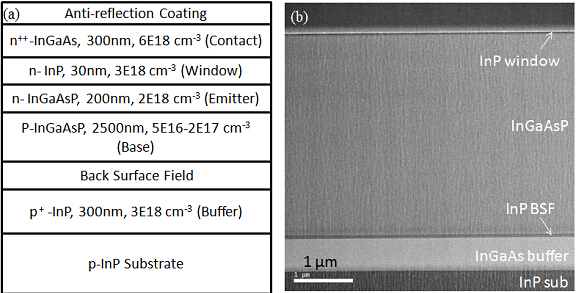Single-junction InGaAsP solar cells with a bandgap of approximately 1.0 eV have recently been the subject of investigations for their use as additional subcells in multi-junction concentrator cells. To date, only a few reports have been published on InGaAsP-based solar cells grown by metalorganic chemical vapor deposition. InGaAsP-based solar cells grown by molecular beam epitaxy (MBE), which in principle gives more precise growth control, have not been reported.
Prof. Shulong Lu’s lab, at Suzhou Institute of Nano-tech and Nano-bionics, Chinese Academy of Sciences has grown InxGa1-xAsyP1-y alloys using solid-source MBE. Solid Ga, In, As, P were used as source material, avoiding extremely toxic hydrides and organometallic compounds used in other epitaxial growth processes.The InGaAsP-based single-junction photovoltaic device with a bandgap of 1 eV was fabricated and an efficiency of 18.8% was obtained under the AM 1.5 G solar spectra. (Solar Energy Materials & Solar Cells, vol137, p68-70, 2015)
The carrier recombination dynamics of InGaAsP with different doping densities have been investigated. The InGaAsP emitter and base layers with a graded doping concentration were designed, aimed at achieving better carrier collection.
Strong spinoidal decomposition was found for the InGaAsP with a bandgap of approximately 1.0 eV. The phase separation causes the degradation of the optical characteristics and results in poor performance of solar cells. The growth temperature of InGaAsP was improved to prevent the phase separation. The minority carrier lifetime has been raised two times and the device efficiency has been increased 15%.
Rapid thermal annealing also has been tried on InGaAsP. The PL intensity of p-type InGaAsP was significantly increased to 166 times and the the minority carrier lifetime was raised about one magnitude. The open voltage of solar cell increased 40% after annealing.
This work was supported by the knowledge Innovation Project of the CAS and the SINANO program.

Fig. 1 Cross-section struction and transmission electronic microscopy of the InGaAsP solar cell.(Image by LU Shulong's Lab)

Fig. 2 PL spectra of InGaAsP and current density–voltage characteristic curve of InGaAsP solar cells.(Image by LU Shulong's Lab)
Reference:
Lian Ji, Shulong Lu, Hui Yang, Investigation of InGaAsP solar cells grown by solid-state molecular beam epitaxy, Solar Energy Materials & Solar Cells, 137, 68-70, 2015
downloadFile
